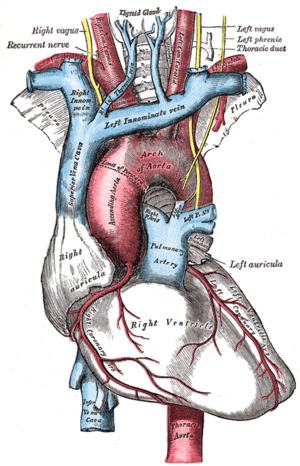Aortic body
The aortic body is one of several small clusters of peripheral chemoreceptors known as glomus cells, baroreceptors, and supporting cells located along the aortic arch.
| Aortic body | |
|---|---|
 The heart, thoracic aorta and other great vessels (aortic body not visible, but aortic arch labeled at center) | |
| Details | |
| Nerve | Vagus nerve |
| Identifiers | |
| Latin | Glomus aorticum, corpora paraaortica |
| MeSH | D001016 |
| Anatomical terminology | |
Some sources equate the "aortic bodies" and "paraaortic bodies", while other sources explicitly distinguish between the two.[1][2] When a distinction is made, the "aortic bodies" are chemoreceptors which regulate the circulatory system, while the "paraaortic bodies" are the chromaffin cells which manufacture catecholamines.[3]
Structure
A chemoreceptor present on the aortic arch.
Function
It measures changes in blood pressure and the composition of arterial blood flowing past it, including the partial pressures of oxygen and carbon dioxide.[4] The chemoreceptors responsible for sensing changes in blood gases are called glomus cells.
It gives feedback to the medulla oblongata, specifically to the dorsal respiratory group, via the afferent branches of the vagus nerve (X). The medulla, in turn, regulates breathing and blood pressure.
Clinical significance
References
- Aortic+Bodies at the US National Library of Medicine Medical Subject Headings (MeSH)
- Para-Aortic+Bodies at the US National Library of Medicine Medical Subject Headings (MeSH)
- Piskuric, Nikol A.; Nurse, Colin A. (2013). "Expanding role of ATP as a versatile messenger at carotid and aortic body chemoreceptors". The Journal of Physiology. 591 (2): 415–422. doi:10.1113/jphysiol.2012.234377. ISSN 0022-3751. PMC 3577521. PMID 23165772.